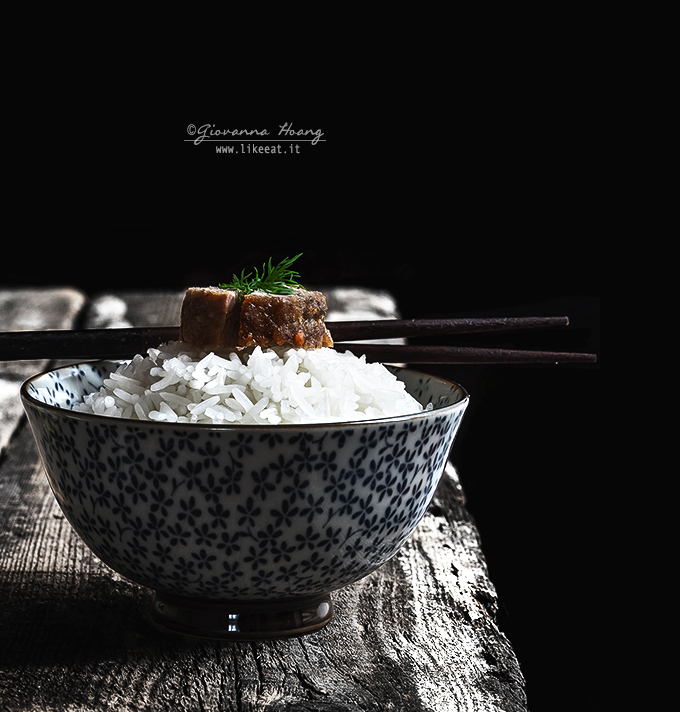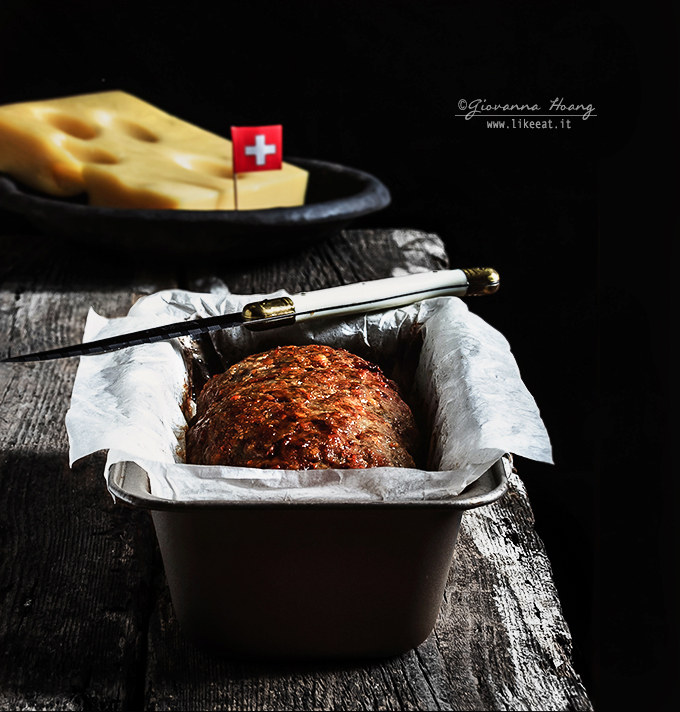Si è soliti dire e si è soliti pensare che il polpettone sia un “affare semplice”.
Lo si prepara in maniera piuttosto veloce, sbrigativa, con un pizzico di questo, un pizzico di quello, una manciata di questo, un po’ di quell’altro e, fondamentalmente, quasi sempre con gli stessi fidi ingredienti, come per essere sicuri di non sbagliare. Un po’ di modellamento, una sistematina in teglia e poi via in forno per non pensarci fino all’ora di pranzo o di cena.
Ma questo polpettone, poichè declinato in versione italo-vietnamita-swiss, di lavoro e lungimiranza ne richiede un pizzichino in più del solito, giacchè tocca prepararlo con un certo anticipo se si vuole ottenere un risultato impeccabile.
E se, ora, vi state domandando: “Ma val la pena provare sta versione quando la solita, quella già collaudata, è più semplice e veloce?”
Vi rispondo: “Sì, qui si crede proprio di sì! Perchè questo intramontabile classico, ha bisogno di essere svecchiato, migliorato, aggiornato coi tempi moderni. Così, lo si è intrecciato con i sapori di diverse culture per renderlo un po’ multietnico. E i palati qua, ne sono rimasti più che soddisfatti. Fidatevi, provate e credete”.
Dunque, prendete nota perchè per farlo si deve partire un po’ da lontano, dalla “storica ricetta” esistente sin dai tempi delle nostre nonne, nel mio caso delle nonne italiane acquisite, con carne trita, un po’ di mortadella, salsiccia a piacimento e della mollica di pane ammollata nel latte per renderlo sofficioso.
E l’uovo che fine ha fatto?
Beh, stavolta si è scelto di abolirlo per gusto personale, ma se lo volete, se preferite… potete tranquillamente reintegrarlo.
Si prosegue, poi, con gli insegnamenti di mamma Quang (la mia mamy) per condire la carne senza eccedere con gli aromi e le spezie, cercando di trovare il giusto equilibrio di sapori.
“Perchè scalogno e aglio servono a profumare la carne e non devono nasconderne il sapore.”
Si dovrà, quindi, preparare una densa pappina frullando questi bulbi con dell’olio evo, di cui se ne userà giusto un paio di cucchiaini, ma quel che avanzerà (don’t worry) si potrà tranquillamente conservare in frigorifero per almeno 1 mese chiuso in un barattolino (l’importante è che sia ben ricoperto di olio).
Successivamente, si bisognerà aggiungere una generosa manciata di Emmental DOP (quello vero però, unicamente svizzero e riconoscibile dai suoi inconfondibili buchi) per arrotondare il sapore in maniera molto Swiss e qualche fogliolina di aneto per dare quel tocco stravagante in più, che non guasta mai.
Una volta amalgamati tutti gli ingredienti, lasciate riposare il polpettone in frigo una notte intera.
Prima di adagiarlo in teglia e infornarlo, però, ricordatevi di verificare se è giusto di sale.
Come insegna mamma Quang, prendete un piccolo quantitativo di carne, tipo mezzo cucchiaio, e cuocetelo in padella. In questa maniera avrete la possibilità di assaggiare in anteprima il polpettone e aggiustarlo eventualmente di sale, pepe, formaggio, spezie o altro per non avere sorprese quando andrete a servirlo.
E ora, fatto anche questo passaggio non vi resta altro che cuocerlo e attendere di gustarlo in tutta la sua bontà! E perchè no, magari alla vietnamese style con del riso pilaf e tante verdurine croccanti. 😉
E questa è la mia ricetta del cuore, quella fatta di tradizioni che s’intrecciano in una trama fitta, fitta di ricordi e di emozioni. La ricetta con la quale partecipo anche quest’anno al contest dei Formaggi Svizzeri in collaborazione con Peperoni e Patate.
#noiCHEESEamo e tu?
Emmental and dill meatloaf
It is generally said and it is customary to think that the meatloaf is a “simple affair”. It is quick to prepared, hasty, with a pinch of this, a dash of that, a handful of this, a bit of that other and, basically, almost always with the same ingredients, as to be sure to not make mistakes. A little of modeling, sprucing up in the pan and then in the oven to not think about it until lunch or dinner time.
But this meatloaf, since declined in version Italian-Vietnamese-Swiss, of work and foresight it requires a pinch more than usual, since it needs to be prepared well in advance if you want to get a perfect result.
And if, now, you’re wondering: “But it is worth trying this version when the usual one, the one already proven, it is easier and faster?”
I answer: “Yes, here it is believed so! Because this timeless classic, it needs to be rejuvenated, improved, updated with modern times. Thus, it is intertwined with the flavors of different cultures to make it a little more multiethnic. And here tastes were more than satisfied. Trust me, try and believe. “
So, make a note because you have to start a little far to do it, from the “historical recipe” existing since the time of our grandmothers, in my case of Italian grandmothers acquired, with ground beef, a bit of mortadella, sausage at will and the crumb of bread soaked in milk to make it soft.
And what happened to the egg?
Well, this time it was decided to abolish it for personal taste, but if you want it or if you like…you can safely reintegrate it.
It continues, then, with the teachings of Quang mom (my mummy) to flavor the meat without exceeding with the aromas and spices, trying to find the right balance of flavors.
“Because shallots and garlic are used to perfume the meat and should not disguise the taste.”
It must, therefore, prepare a thick mush blending these bulbs with some olive oil, of which it will use just a couple of spoons, but what will advance (don’t worry) you can safely refrigerate for at least 1 month closed in a jar (the important thing is that it is well coated with oil).
Next, you need to add a generous handful of Emmental DOP (the real one, however, only the Swiss and recognizable by its distinctive holes) to round the taste off in a very Swiss way and a few leaves of dill to give that extra bit of extravagance, which never hurts.
Once blended all the ingredients, let stand the meatloaf in the refrigerator overnight.
Before you lay it on the baking sheet and bake, however, remember to check if it is the right of salt. As mom Quang teaches, take a small amount of meat (as half spoon) and cook in the pan. In this way you will have the chance to taste preview the meatloaf and if necessary adjust the salt, pepper, cheese, spices or other, to avoid surprises when you’ll serve it.
And now, after this step you’ll just have to cook and wait to taste it in all its goodness! And why not, maybe the vietnamese style with pilaf rice and many crunchy vegetables.
700 gr of lean ground beef
150 gr of luganiga (or sausage)
150 gr of mortadella
100 gr of Emmental
100 gr of bread
3 coffee cups of milk (or a little more, in need)
3 tablespoons chopped dill
3-4 cloves of garlic
1 shallot
Salt
Pepper
Nutmeg
Extra virgin olive oil
Doses for 6 people
Cooking time 60 minutes
In a mixer (or mini cutter) whisk 1 shallot with 4 cloves of garlic and lots of oil just enough to cover the bulbs. Remove the gut to luganiga. With the help of the mixer (or mini cutter) separately chopped mortadella, Emmentaler and stale bread. Then, soaked the last one in milk and wait it to revive before join it to the other ingredients. In the case that the bread is too dry, add a little more milk, but do not overdo it because it doesn’t have to seem a soup.
In a large bowl mix the beef, mortadella and luganiga with a couple of teaspoons of shallots and garlic whip. Next, add some grated nutmeg, chopped dill, Emmentaler, add salt and pepper and mix again. Finally, add the bread and mixing it well with your hands. Cover the bowl with plastic wrap and let stand in refrigerator overnight.
Line a baking plumcakes with baking paper leaving the flaps protrude from the mold, so as to facilitate later extraction of meatloaf.
Check if the meat is just salt as explained above in the post, then shape it with your hands to give her a very compact form, place them in the mold and brush the surface with oil.
Bake the meatloaf for 1 hour at 160° degrees.
The end result will be extremely luxurious: golden and crunchy outside, soft and juicy inside.
And this is my favourite recipe, the one made of traditions that are interwoven into a dense texture, full of memories and emotions. The recipe with which I attend the contest this year of Swiss Cheese in collaboration with Peperoni e Patate.
#noiCHEESEamo and you?
Volete una ricetta ricca e succulenta per i grandi pranzi in famiglia? Allora dovete assolutamente provare questo polpettone all’Emmental e aneto!
-
Dosi per
6 persone -
Tempo di preparazione
20 MInuti -
Tempo di Attesa
30 MInuti -
Tempo di cottura
1 Ora -
Tempo totale
1 Ora 40 MInuti
Ingredienti
- 700 gr di carne di manzo macinata
- 150 gr di luganiga (o salsiccia)
- 150 gr di mortadella
- 100 gr di Emmental
- 100 gr di pane raffermo
- 3 tazzine di latte
- 3 cucchiai di aneto tritato
- 4 spicchi di aglio
- 1 scalogno
- un pizzico di noce moscata
- q.b. olio evo
- q.b. sale
- q.b. pepe
Procedimento
-
In un mixer (o mini cutter) frullate 1 scalogno con 4 spicchi di aglio e tanto olio quanto basta per ricoprire i bulbi.
-
Private la luganiga del budello.
Tritate separatamente la mortadella, l'Emmentaler e il pane raffermo con il mixer. - Ammollate il pane nel latte e aspettate che rinvenga prima di unirlo agli altri ingredienti. Nel caso in cui il pane risultasse troppo asciutto, aggiungete ancora un poco dil latte, ma senza esagerare perchè non deve risultare una zuppa.
-
In una ciotola capiente mescolate la carne di manzo, la mortadella e la luganiga con un paio di cucchiaini di frullato di scalogno e aglio.
Successivamente, aggiungete una grattata di noce moscata, l'aneto tritato, l'Emmentaler, salate, pepate e amalgamate nuovamente.
Infine, unite il pane e amalgamate bene il tutto impastandolo bene con le mani.
Coprite la ciotola con della pellicola alimentare e lasciate riposare in frigorifero per 30 minuti o una notte intera.
- Foderate una teglia da plumcake con della carta forno lasciando che i lembi fuoriescano dallo stampo, così da agevolare in seguito l’estrazione del polpettone.
- Verificate se l carne è giusta di sale come spiegato sopra nel post, poi modellatela con le mani per darle una forma ben compatta, adagiatela nello stampo e spennellate la superfice con dell'olio.
-
Cuocete il polpettone per 1 ora circa a 160° gradi.
Una volta cotto, toglietelo dal forno, coprite la teglia con della stagnola e lasciate riposare per una decina di minuti prima di tagliarlo.
















Credo che fotografare un polpettone sia davvero difficile! Si si lo penso…io ancora non ci sono riuscita…tu…tu invece hai fatto delle fotografie che sembrano dei quadri…sono stupende ed io come sempre mi perdo fra i tuoi scatti…
Molto molto bella anche la tua proposta culinaria ovviamente…
Ti abbraccio!!
Ila
Ilariaaa ♥ ♥ ♥